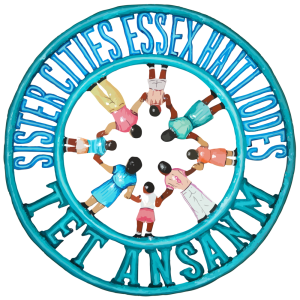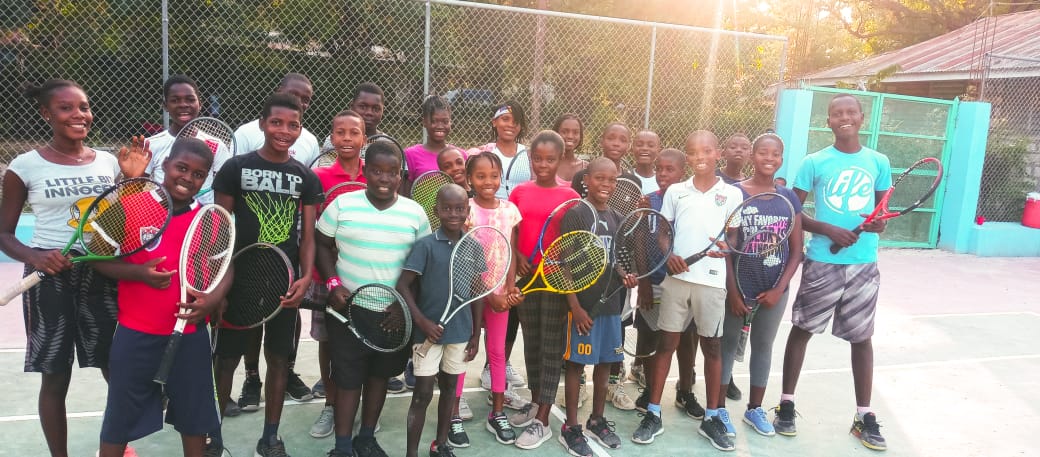SCEH EETT workshop August 2013.
Vera Dowell, Diane Huot, and Bob Lamothe joined Jenifer Grant for the second phase of the EETT project. Six of the original students from the April 2012 workshop were comfortable enough with their knowledge and familiarity of what we had presented and what they had integrated into their schools to take responsibility for being the leaders or “formateurs” for the workshop or “formation.”
The trip began at Bradley for Jenifer, Diane and Bob. We each had two 50 lb bags, four of which were filled with manipulative materials and books, enough for the 10 new schools and the five schools who had participated in the original workshop.
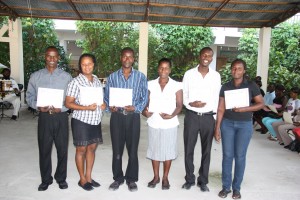
We met with Kettelie Petit-Loute, Odverne Charles, Marie Antoine Joseph, Wisly Demaran, Jean Edridge Cadet, and Wednise Beaubrun on Friday before the week long workshop to work with them to finalze their plan. After discussion, when they continued to defer to us, and we were all too happy to give out ideas, Vera reminded them that the workshop was in their hands and that they needed to do the planning and we would step away to give them more freedom to plan themselves. Best idea so far! By the end of the morning when we regrouped, they had formulated the plan with each person taking responsibility for different aspects, and everyone felt ready to proceed for Monday.
Kettelie was kind enough to hold the workshop again a second time in her school. She had cleared the room of all vestiges of her materials which are more numerous than any of the other schools, set up tables and enough chairs for the new participants.
As supporters and purveyor of materials and books, we arrived on Monday morning at 7:00 to help set out the materials for the day. The teachers began to arrive at 8:00 and as in the former workshop, they were unsure of what to do with the puzzles, unifix cubes, and other materials. Although we encouraged them to “adventure” they were tenuous in their approaches.
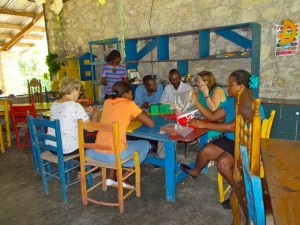
The formal day began at 9:00, a little later than anticipated as the participants straggled in. The morning focused on ways to start the day and how to teach the letters to the youngest children. The morning continued, shifting from having the participants put themselves in the shoes of their students to discussion as adult teachers. Outdoor and indoor physical activities actually doing the activities as students would were as good a break for the adults as they are for the children! The workshop also included singing at every opportunity as a teaching tool for almost every subject. The first day ended with a “histoire” which was a story related by Jean Edridge.
Our goal was to have the formateurs convey to the new group the value of maniuplative materials for learning as well as the value of reading to the children. We also hoped they would incorporate ways to give the children more independence such as taking their own attendance. Two of the ways were using craft sticks and wooden clothespins with their names which they picked up on arrival and placed in the appointed spot. We also hoped that they would convey the value of having materials for the children to explore when they arrived at school until the formal day began.
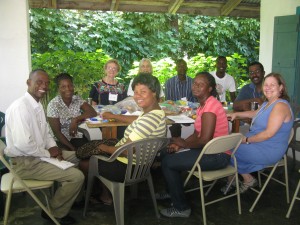
The formateurs or Haitian leaders, were sandwiched between having their former teachers watching them teach a new group and being responsible, probably for the first time, for teaching fellow teachers new concepts. They grew in their confidence as the days progressed. Each day began and ended with a prayer, each time delivered by different person. Prayer is very much a part of the lives of Haitian people, at meetings, schools, and in their personal lives.
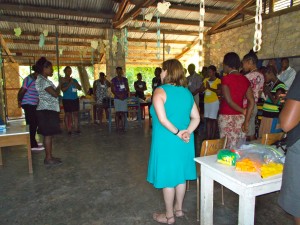
Throughout the workshop we were impressed with the wealth and depth of traditional Haitian presentations of material. Songs for almost every occasion, leaning days of the week, individual letters, etc. Although we had come the year before with some of the traditional activities used in US schools for physical activities such as “you put your right foot in, you put your right foot out…” they brought out a wealth of Haitian activities that did the same thing.
At a “learning to read” session, one of the formateurs presented a blackbord lesson on what we thought would be familiar to everyone; the joining of a consonant with each vowel to produce different sounds. We learned later that this particular approach is not widely used or understood, so it was indeed a valuable lesson.
Each day included a story either read or told orally and activities to review the story which ranged from drawing three scenes of different parts of the story, to re-enacting as a play (definitely the favorite).
One learning lesson was conducted outdoors, focusing on the cycle of life of a mango tree, from mango to tree to peeling the mango to find the seed.
Probably the most wonderful and successful activity was Vera’s homework assignment after her class on the value of the use of unifix cubes to explore the number 3. The teachers were assigned to bring in three of something- they could be things that were similar or different. It was evident when a large number of participants presented three leaves, all from a nearby tree, that some had forgotten the homework, but quickly solved the problem. Each person presented his or her items. The first couple of presenters stood, showed what they had brought and counted the number.
As the presentations proceeded, some began to say – I have three whatevers – one in one hand, two in the other and saying 1 plus 2 equals 3. Or – I have three bottle caps – one is green the others are red- 1 pus two equals three. Then each successive person began to adventure…. I have three kenep (fruit) – counting one, two, three. I give one to “x” and now I have two. All the combinations of three were presented: 2 +1, 1+2, 1+1+1, 3-1 3-2 and the best was when an elderly man who had been quite reserved much of the workshop stated, “I Have three limes. I am giving all three to “X” and now I have none. 3-3 = 0.”as he smiled benevolently at the recipient.
Repetition is a key element especially in Haitian learning which is often oral and rote in great part due to lack of materials. It is often a repetition of addition facts, without any visual aids. This lesson was both visual and held the attention of each person in the group as well as repetitive as far as the number 3 would allow. The fact that successive presenters became more imaginative and every student was attentive to each presenter was indeed one of the highlights of our joy in what they were accomplishing with the hope that each of them would return to their classes and use both the visual and individual presentations to see and understand concepts.
Transitions from one period of activity to another is challenging for all culures. The traditional Haitian way of making transitions is to close down the work being done by saying “OK OK OK?” – the “students reply “ok, ok, ok !” this happens perhaps three times and voila – everyone is ready for the transition.
Sessions included “teacher to teacher” sessions where a formateur would present information. Bob Lamothe talked about the difference in the approach to learning between the Haitian schools and the American schools. Having attended Haitian schools until the age of 12 when he emigrated to the US and where he continued his education, his presentation was especially credible to the attendees. He especially noted the Haitian tradition of memorizing without much opportunity for questioning. This prompted many questions including the US system of higher education, how public schools are funded, and quality of schools. He also stressed that the US schools have a myriad of materials, both consumable and long lasting. The lack of these materials in the Haitian schools sometimes serves as an advantage to both the teachers and the children in Haiti as they are forced to use their own imaginations and be creative.
Following the end of each morning session, the SCEH team and the Haiti formateurs would sit for as long as an hour reviewing the morning. Vera asked them each day to tell what they thought about their own presentations for the day, both “successful” and “needing work” and then we progressed to comments about the day in general or lessons in particular, all with positive voices.
The end of our last day was getting feedback from the “students.” Responses included “this is the best workshop I have attended” “I learned a great deal” “it has helped me understand how children learn” to “I want to attend the next workshop.”
A comment which was echoed was that some were disappointed that there was no food. After further discussion with the formateurs at our final debrifing with them, we learned that almost all workshops entail food. Some serve coffee and a breakfast something upon arrival, customarily there is a mid day meal, and then at the end a little something – The previous year at our first workshop, we had provided sandwiches each day and then continued until 2:30. We found that the participants were quite tired in the afternoons, so we (the US team) decided in advance that this year we would start at 8:00 and end at noon or 12:30 and we would provide water and little breads and jam at a mid morning break. In retrospect, we realized that in the future, we should provide food to be in step with Haitian tradition. One of the reasons we resorted to the shorter day and only a mid morning snack was because I (Jenifer) could not figure out how to provide food for five days in a row to 35 people. Kettelie reported that they could find someone local to provide the food and the cost might be c. $400 US for the week. This is something we should add to our budgets for the workshops.
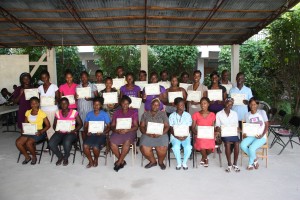
Each “student” and each “formateur” received beautiful certificates at a special ODES meeting. The Certificates were designed by Besly Belizaire, each with the participants name written in wonderful computer calligraphy. The ODES meeting also included awards to the winners of a month long youth tennis tournament. Often the Fanfare Band will perform at such a gathering but this time the musicians were all the students (about 15) who have been learning to play under the tutelage of the Fanfare musicians. They have been studying for about 9 months, all with his/her own instrument, thanks to the continued support of Sigma Alpha Iota, our wonderful musical fraternity’s People to People program. They played several pieces together, all from the skill books which we had brought down and using the stands which we had brought back in June 2011. A wonderful end to a wonderful week.

